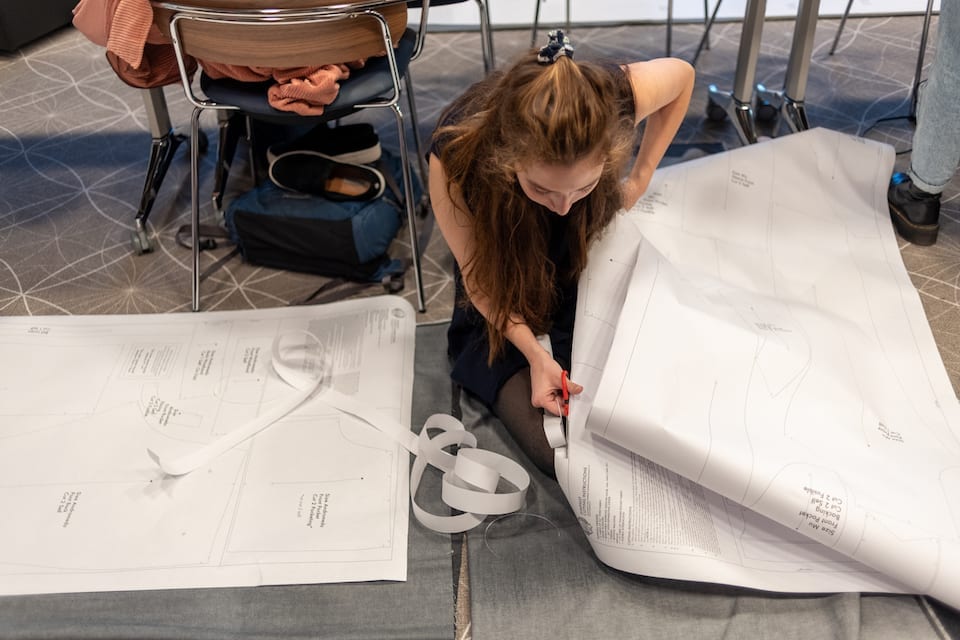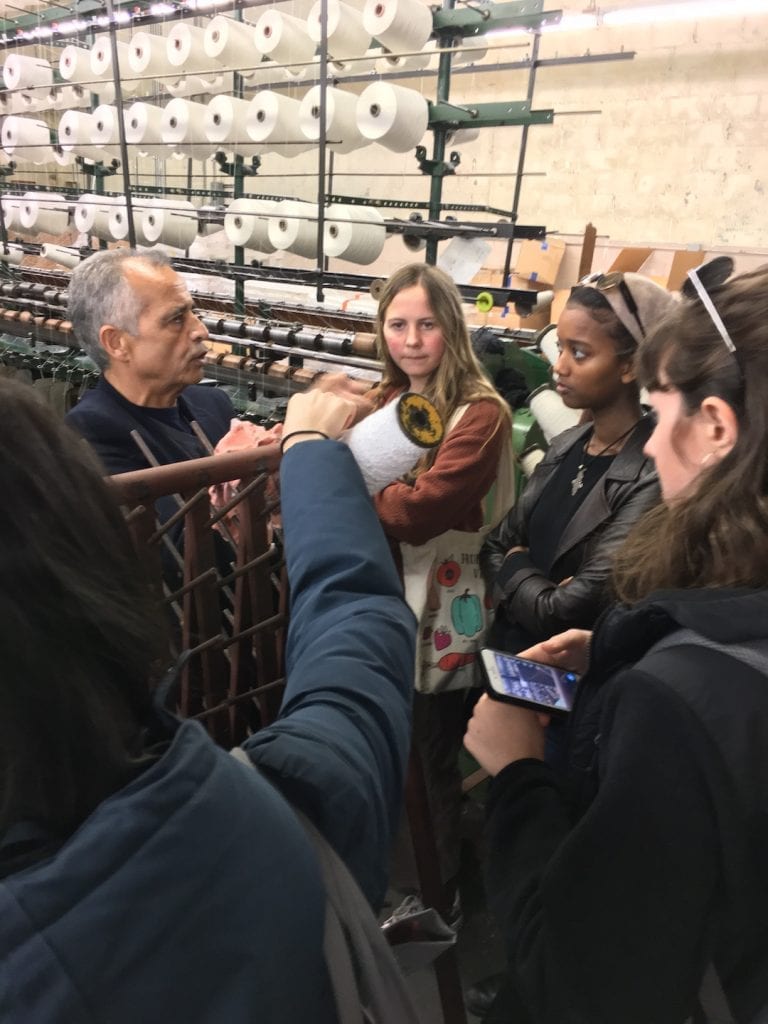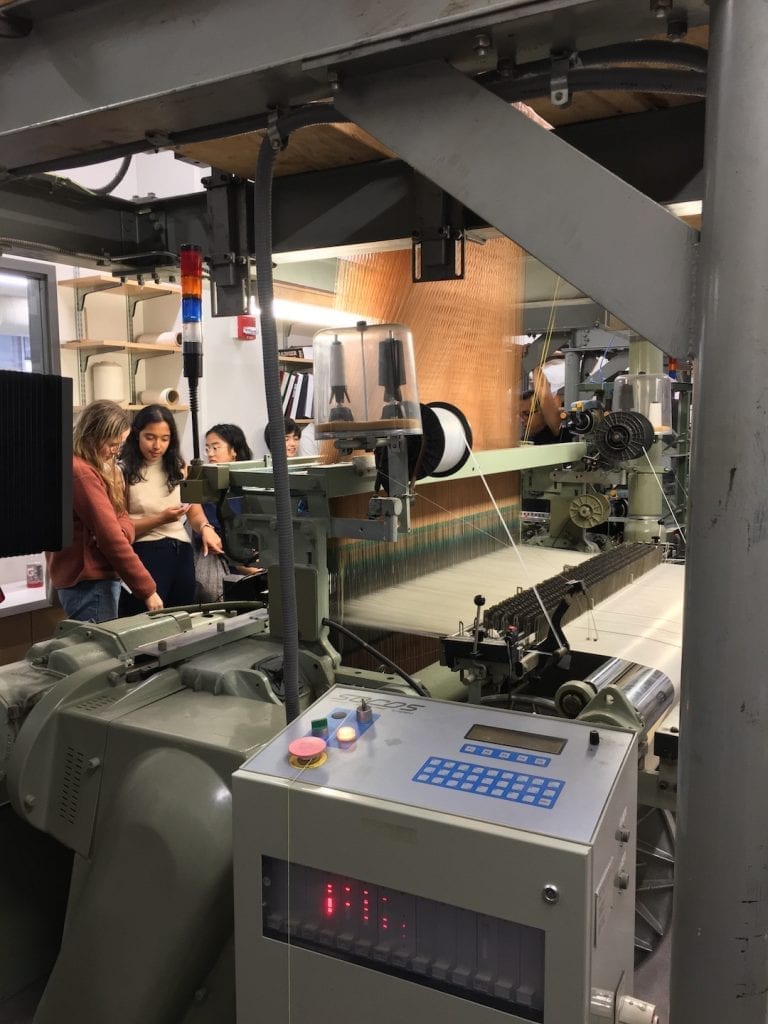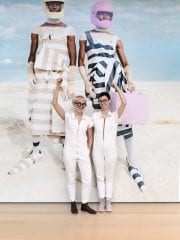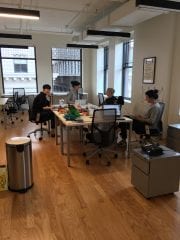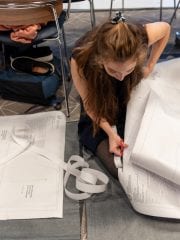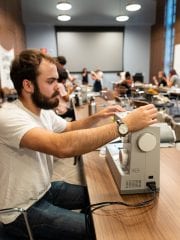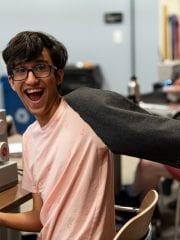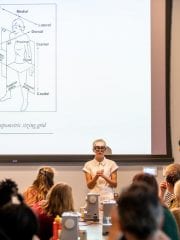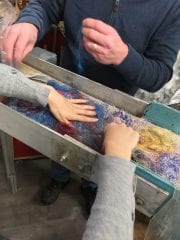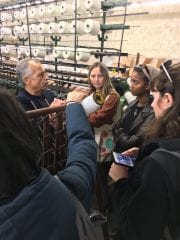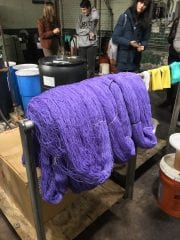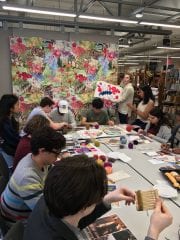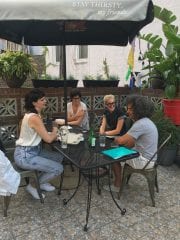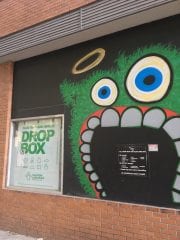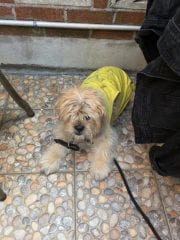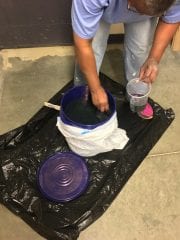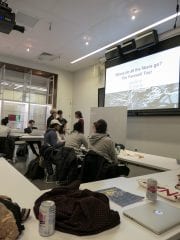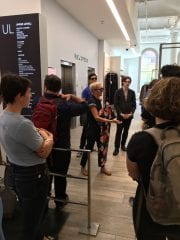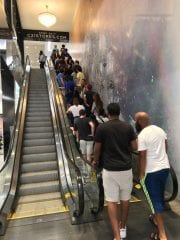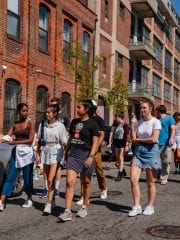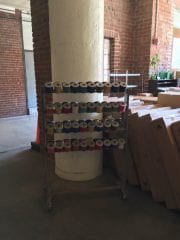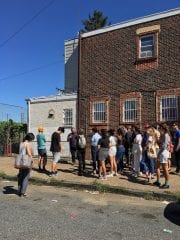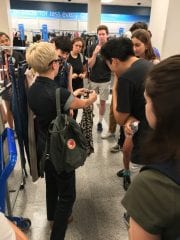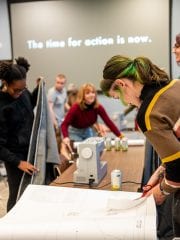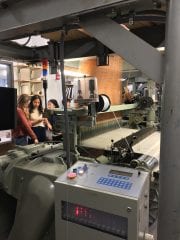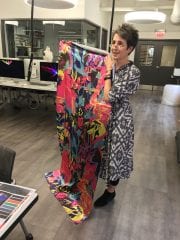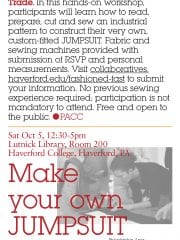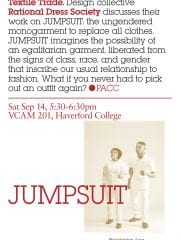Fall 2019
Introduction
The way that we manufacture textiles today is informed by several interconnected pressures: function, economics, labor, society, and fashion. As we better understand the impact of our consumer habits and manufacturing standards on the environment, paired with technological advancements, we are witnessing an industry response to move towards sustainable and circular practices. How does this environmental push negotiate with protecting the rights of people in the textile trade? Through ‘Fashioned Fast: (Re)forming the textile trade’, we will investigate processes, practices, and innovations around the production and recycling of fabrics, rooted in Philadelphia’s intimate history as a leader of the US textile sector.
This project was active during Fall 2019. The planning for this project began a semester in advance, and follow-up extended past the active period.
Collaborators

Lead Artists
The Rational Dress Society is a counter-fashion collective founded by Chicago-based designer Abigail Glaum-Lathbury and Los Angeles-based artist Maura Brewer. Together they produce JUMPSUIT, an open source, ungendered monogarment to replace all clothes in perpetuity. JUMPSUIT has been exhibited nationally and internationally, at venues including MoMA and Art in General in New York and the MCA in Chicago. The Rational Dress Society received an International Cultural Exchange Grant from the Swedish Art Grants Committee in 2015, and was the recipient of CCI’s Creative Economic Development Grant in 2016 and 2018. Press includes the Guardian, the Paris Review and CBS news
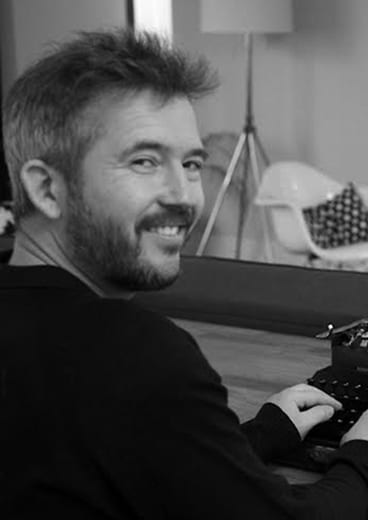
Project Director
Hidden City
A Philadelphia native, Peter graduated from the University of California at Berkeley’s Graduate School of Journalism in 2001. He worked as a newspaper reporter for the Sacramento Bee and the Biloxi Sun Herald, and his freelance writing and photography has appeared in the Cairo Times, the East Bay Express, Philadelphia City Paper, Philadelphia Weekly, and the Philadelphia Inquirer. Peter co-founded the Hidden City Daily, a website that covers architecture, design, development, preservation, and public art in Philadelphia. He also produced the second Hidden City Festival. Peter has created tours for a number of local institutions, including the Mutter Museum, Night Market, Moore College of Art, the Pennsylvania Academy of Fine Arts. Peter is the founding editor of Extant Magazine, published by the Preservation Alliance of Greater Philadelphia, and is currently the magazine’s photo editor. Peter is the co-author of Philadelphia: Finding the Hidden City, (Temple University Press).

Visiting Assistant Professor of Environmental Studies
Haverford College
Elisabeth Evans is a Visiting Assistant Professor of Environmental Studies. Elisabeth did her undergraduate training in architecture at MIT and received her PhD in biotechnology at Brown University. Elisabeth has a broad range of teaching and research experiences employing a cross-disciplinary approach in her work, which encompasses architectural design, biomedical sciences, visual media, and the environment. Elisabeth has significant experience with STEM education, particularly in merging STEM and the arts (STEAM). She has also been engaged in outreach programs geared towards the inclusion of student populations that perceive science to be inaccessible.
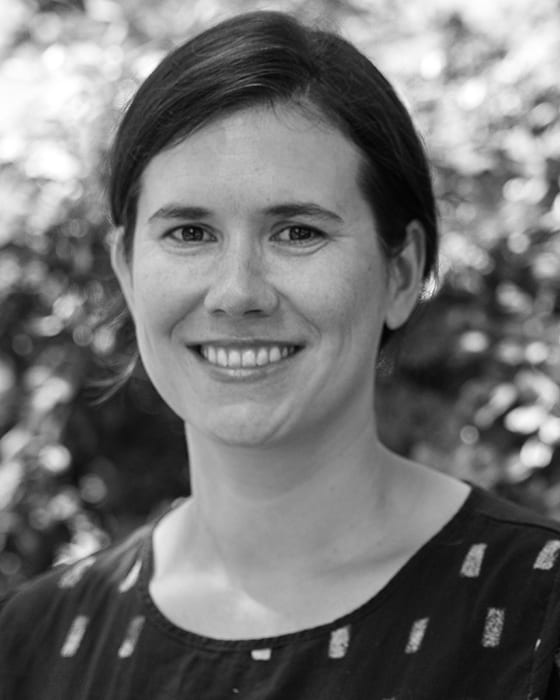
Associate Professor of Chemistry and Environmental Studies
Haverford College
I received an M. Chem degree in Chemistry from the University of Sussex, U.K. in 2000 and a Ph.D. in Chemical Oceanography from the Massachusetts Institute of Technology and Woods Hole Oceanographic Institution (WHOI) Joint program in 2006. After teaching Oceanography at Boston University for a year, I was awarded a Microbial Science Initiative postdoctoral fellowship in 2007 from Harvard University. I joined the faculty of the Chemistry department at Haverford College in July, 2009 and am also a member of the Bryn Mawr and Haverford Bi-College Environmental Studies department. I enjoy working with students from all disciplines to enhance our understanding of the environment. I am particularly interested in using chemical and molecular biological approaches to examine the impact of human-derived chemicals on the World’s Oceans.
Events
Hidden City Philadelphia: Peter Woodall, Project Director
Non-Profit Partner
The Philadelphia Building, 1315 Walnut Street, Suite 320, Philadelphia, PA

Hidden City Philadelphia is dedicated to exploring Philadelphia’s urban landscape in all its complexity through journalism and public history.
The Hidden City Daily, our online publication, acts as a watchdog for historic preservation in Philadelphia. We also delve deeply into architecture, urbanism, photography, public art, city life, and Philly history. Our goal is to surprise, delight, and inform our readers.
Our Hidden City Tours aim to change the way local folks look at familiar places, and to illuminate Philadelphia’s often neglected post-colonial history. Tours range from members-only visits inside extraordinary sites such as the vacant Red Bell Brewery to walking tours that explore places such as Mt. Moriah Cemetery, the Lost Jewish Quarter, and Subterranean Philadelphia.
Photo Credit: Michael Bixler
Rational Dress Society, Lead Artists
Artists in Residence
![]()
The Rational Dress Society is a counter-fashion collective founded by Chicago-based designer Abigail Glaum-Lathbury and Los Angeles-based artist Maura Brewer. Together they produce JUMPSUIT, an open source, ungendered monogarment to replace all clothes in perpetuity. In addition to maintaining a separate artistic practices, Maura and Abigail will be on campus throughout the Fall 2019 semester.
Photo Credit: Rational Dress Society
JUMPSUIT w/ Rational Dress Society
Presentation & Discussion
9.14
5:30-6:30pm, VCAM, Haverford College
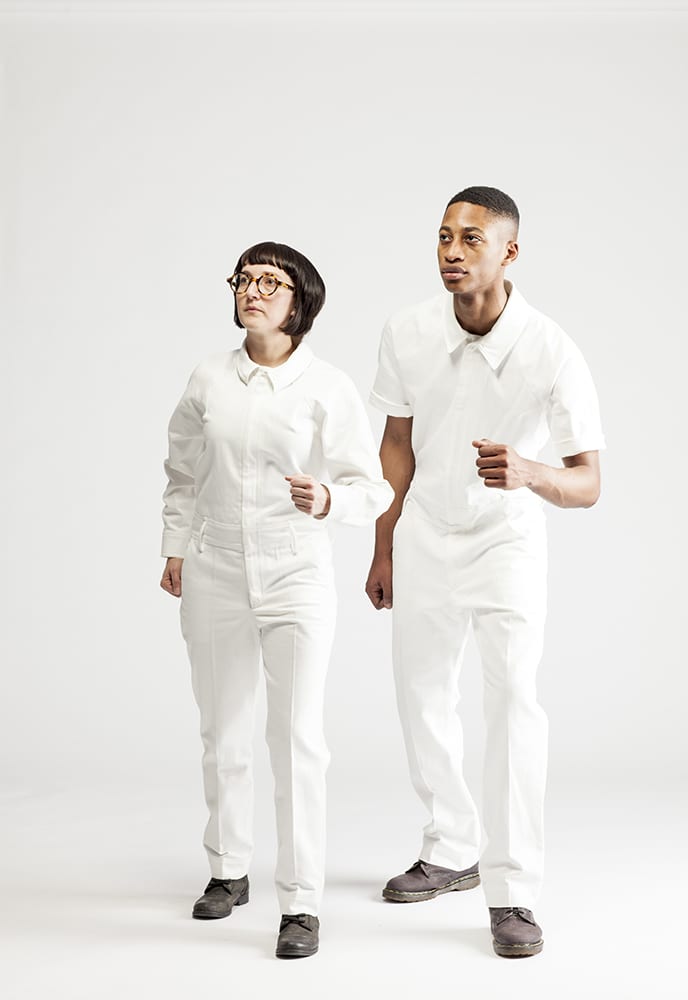
JUMPSUIT: presented by Rational Dress Society
Design collective Rational Dress Society discusses their work on JUMPSUIT: the ungendered monogarment to replace all clothes. JUMPSUIT imagines the possibility of an egalitarian garment, liberated from the signs of class, race, and gender that inscribe our usual relationship to fashion. What if you never had to pick out an outfit again?
Photo Credit: Rational Dress Society
Textile Tour in Philadelphia with Rational Dress Society, Hidden City Philadelphia, & Jacob Downs
Field Trip
9.15
1:30-4:00pm, Harrowgate Park, Globe Dye Works & The Fashion District, Philadelphia, PA
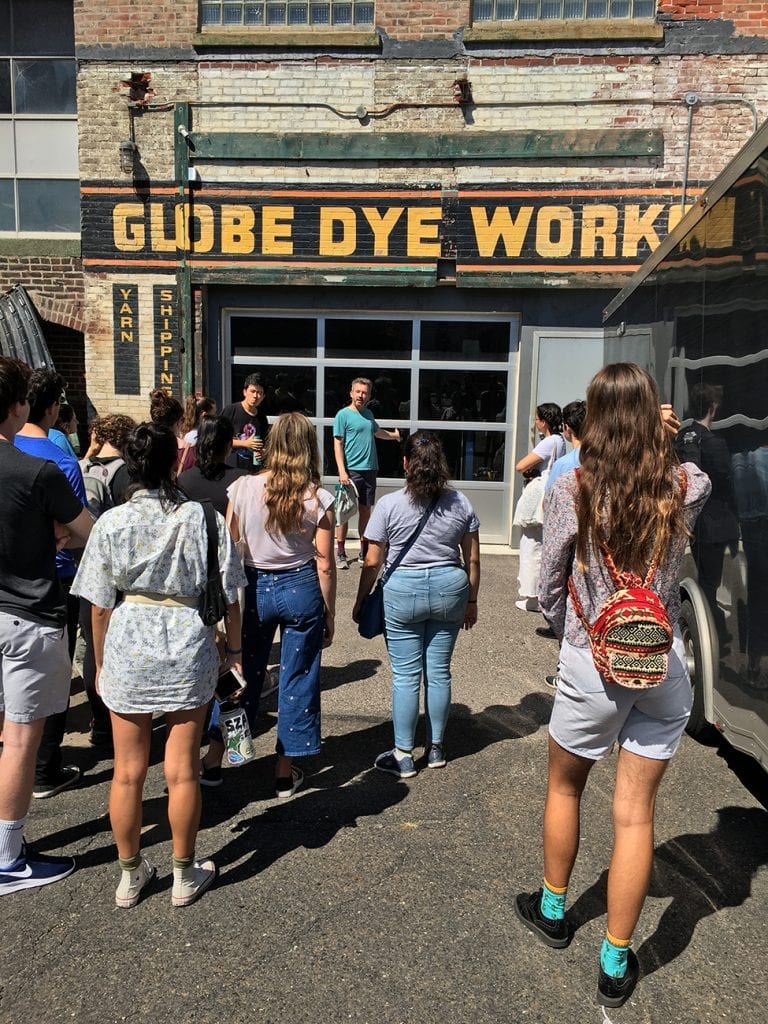
Rational Dress Society, Hidden City Philadelphia, and students from Elisabeth Evans’ course “Industry & the Environment: Understanding Environmental Responsibility within the Textile Industry” toured historic textile sites at Globe Dye Works, the Harrowgate neighborhood, and in Philadelphia’s Fashion District.
The tour started at Globe Dye Works, where we met up with Peter Woodall from Hidden City Philadelphia. Owned and operated by the Greenwood Family until 2005, the facilities – composed of several buildings spread over multiple city blocks – was a major bleaching and dyeing house of cotton yarns and warps.
For a more detailed history of Globe Dye Works and Philadelphia’s industrial past, visit Workshop of the World: Globe Dye Works
Next, Jacob Downs, Historian, and Scholar from the Science History Institute met us at Harrowgate Park, a neighborhood with a long history in the textile industry. As the group explored the park on foot, Downs illuminated the specific challenges of the folks who live in the Harrowgate neighborhood related to an ongoing history of racism and classism. Downs has published a few pieces in relation to these issues:
Industrial Neighborhoods
Walking Encyclopedia: Harrowgate
The last stop we made was at Ross and Century 21 clothing stores on Market Street in the Fashion District. We met up with Abigail Glaum-Lathbury and Maura Brewer of Rational Dress Society who took the group inside each store for discussion about labor and materials in fashion production. In Ross, we talked about what kind of stitches are used to finish clothes and how those stitches translate to quality and labor time for a factory worker. In Century 21, Abigail used a pair of jeans off the rack to deconstruct the process of making one of the most common pieces of clothing worn by every class of people in the world.
Photo Credit: Stephanie Bursese
Make your own JUMPSUIT w/ Rational Dress Society
Workshop
10.5
12:30-5pm, Lutnick Library, Haverford College
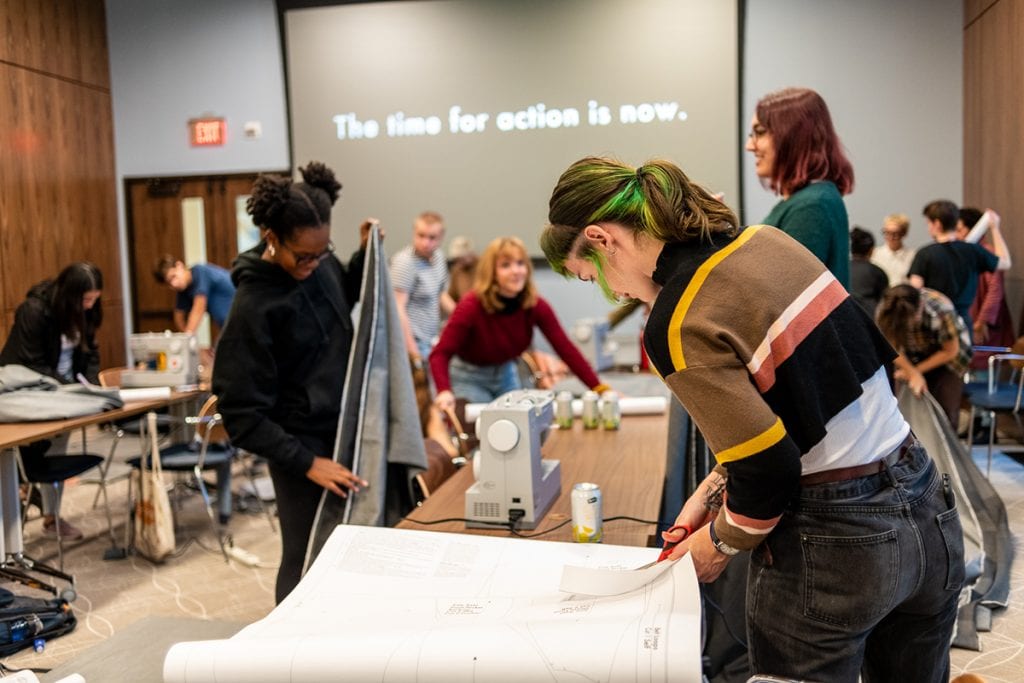
What if you never had to pick out an outfit again? In this hands-on workshop, participants will learn how to read, prepare, cut, and sew an industrial pattern in service of constructing their own, custom-fitted, Rational Dress Society JUMPSUIT. Fabric for the monograment, sewing machines, and custom pattern provided with the submission of RSVP and individual measurements, no previous sewing experience required!
Space is limited for participation (option 2); please read through the details below and as measurements are submitted via google forms, we will update this page with availability. Participation is not mandatory to attend, free, and open to the public. Haverford College and Lutnick Library are ADA accessible spaces.
3 Types of participation:
1 – ATTEND
This event does not require that you submit any information and RSVP is not required to be an audience member, please join us for all or part of the workshop.
2 – PARTICIPATE AND MAKE A JUMPSUIT / DEADLINE: SEPTEMBER 30TH
In order to print your mono garment pattern, we need measurements from you to ensure a utopian fit.
To take these measurements you will simply need a flexible measuring tape and ideally, a comrade to assist you. Please follow this link to an instructional video of the official Rational Dress Society Guide to Measuring.
Your height
Your chest measurement – measured at the widest point of the body
Your waist measurement – measured at the narrowest point of the body
Your low hip measurement – measured around the fullest point including your full bum!!
And your preference for a fitted JUMPSUIT or an unfitted JUMPSUIT – fitted means that there are bust darts to accommodate breasts, and unfitted means a slightly more relaxed or masculine fit.
Once you have your measurements, please fill out this Google Form with your measurements, information, and preferences.
3- PICK UP A CUSTOM PATTERN AND FABRIC / DEADLINE: SEPTEMBER 30TH
If you would like us to print a custom JUMPSUIT pattern for you and purchase 3 yards of fabric, but prefer to sew the garment at home following RDS’ instructional step-by-step videos, please fill out the Google Form and pick up your pattern and fabric at the workshop on October 5th.
For the workshop, we will have some fabric on hand, but we highly recommend that you bring your own fabric! Past participants have brought everything from polka dot to hand-printed textiles. If you do bring your own fabric we recommend that you purchase 3 yards of a woven (non-stretch fabric). For beginning stitchers simple twill, denim and chambray fabrics are very easy to work with.
Photo Credit: Constance Mensh
Should We Ban Unsold Fashion Waste? Panel at Fashion Institute of Technology
Field Trip
10.15
6-7pm, FIT, 227 W 27th St, New York, NY
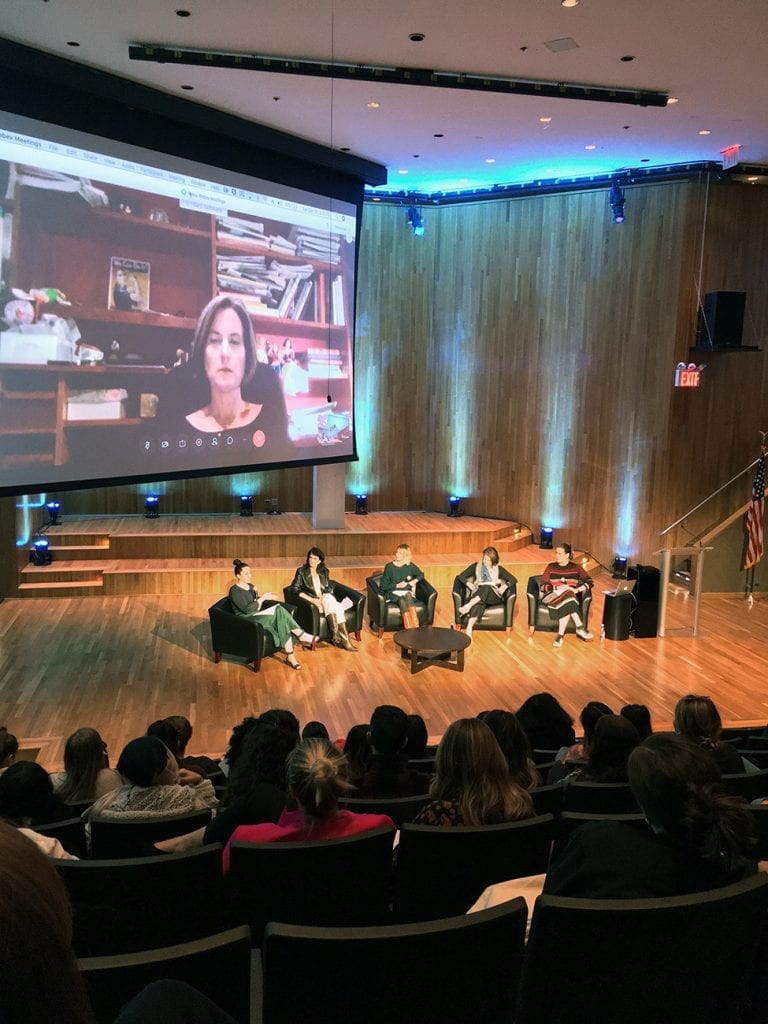
Should We Ban Unsold Fashion Waste? Panel at Fashion Institute of Technology
Burberry was caught destroying millions of dollars of unsold merchandise in 2018, revealing a pervasive and hidden industry practice to an outraged public. What’s the solution to fashion’s waste crisis? In France, the answer has been to ban the destruction of unsold apparel goods. Should the US follow? A panel of policy and textile waste experts debate the pros and cons of enacting a ban on the destruction of unsold apparel goods.
Panelists:
Elizabeth L. Cline, author of The Conscious Closet
Ariele Elia, industry/project coordinator for the MFA Fashion Design program at FIT
Lauren Fay, founder, The New Fashion Initiative (TNFI)
Hilary Jochmans, president of Jochmans Consulting, LLC
Jessica Schreiber, executive director of FABSCRAP
Sara Ziff, founding director of the Model Alliance
Photo Credit: Stephanie Bursese
Topics in Environmental Chemistry Presentations w/ Hidden City Philadelphia and Rational Dress Society
Student Presentation & Artist Talk
10.24
6-9pm, VCAM, Haverford College
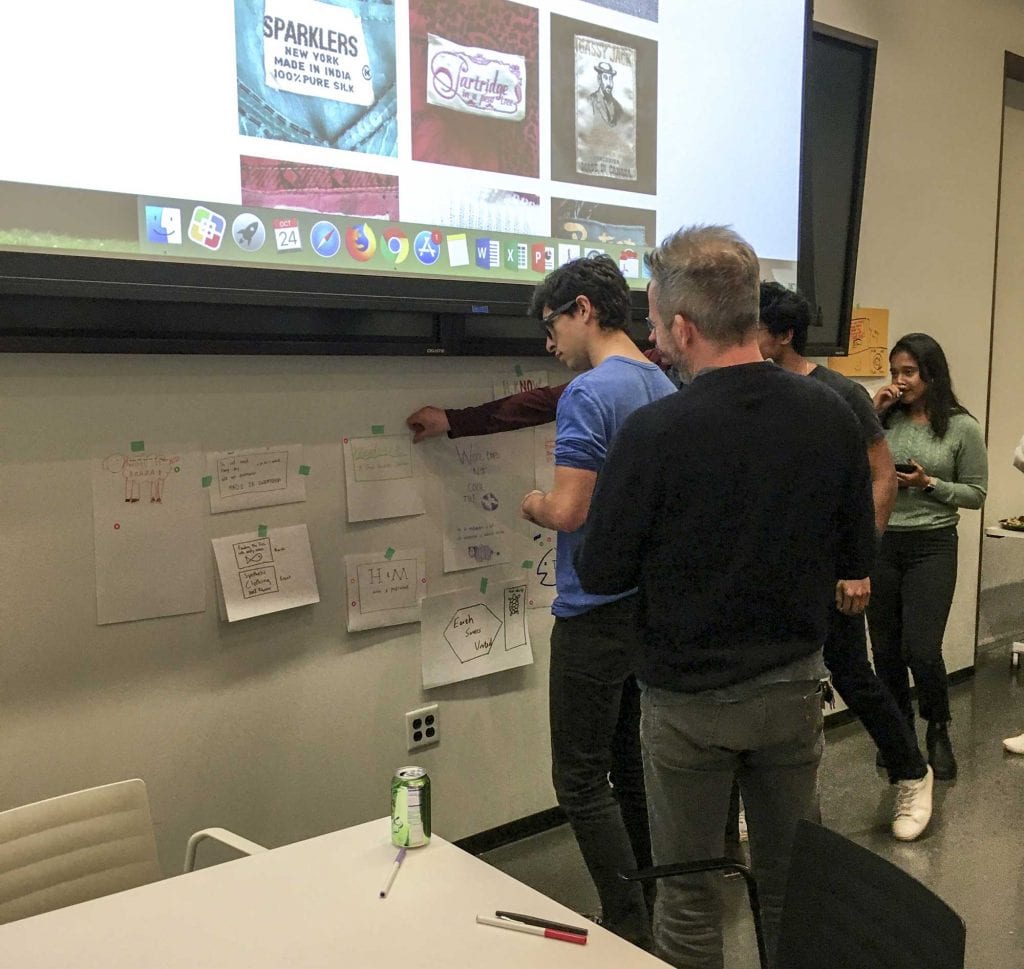
Students from Helen White’s course, “Topics in Environmental Chemistry”, presented their half semester-long projects. Peter Woodall, Project Director at Hidden City Philadelphia, talked about the role journalism plays in disseminating scientific information and how important information can get lost or misinterpreted if the writer is not acquainted with the subject matter in the piece.
Photo Credit: Stephanie Bursese
Thomas Jefferson University Textile and Design Facilities Tour and Workshop w/ Marcia Weiss, Director Fashion, Textiles and Futures Center
Field Trip
10.25
1:45-4pm, Thomas Jefferson University East Falls Campus, 4201 Henry Ave, Philadelphia, PA
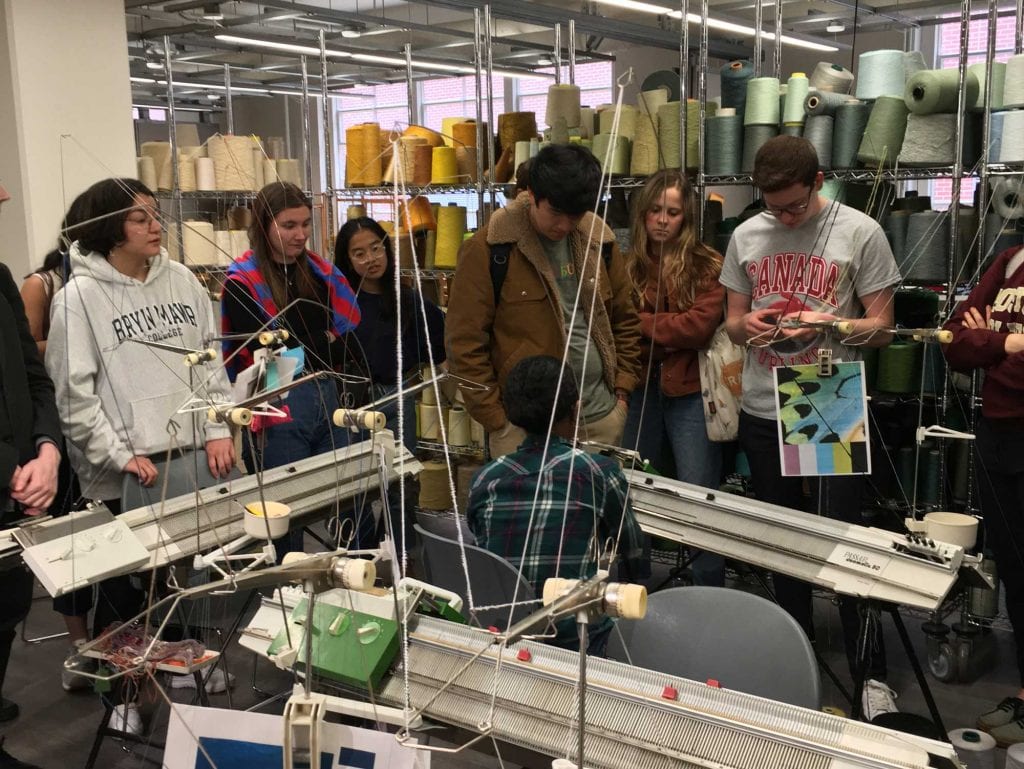
Students from Elisabeth Evans’ course “Industry & the Environment: Understanding Environmental Responsibility within the Textile Industry” toured Thomas Jefferson University’s Textiles and Futures Center. During the tour, led by Marcia Weiss, Director Fashion, Textiles, and Futures Center at Jefferson, taught the students about both small scale textile production on the manual looms as well as large scale textile production with the industrial, computerized loom. Graduate students from the textile engineering program met the group along the way, sharing some of their current projects and samples of in-process fabrics. After touring the building and learning about the program, to conclude, the Haverford students sat down and worked on a small hand-loom weaving project to take home.
Photo Credit: Stephanie Bursese
Open Hours: Sewing w/ Paige Fetchen
Workshop
Multiple
2-6pm, VCAM, Haverford College
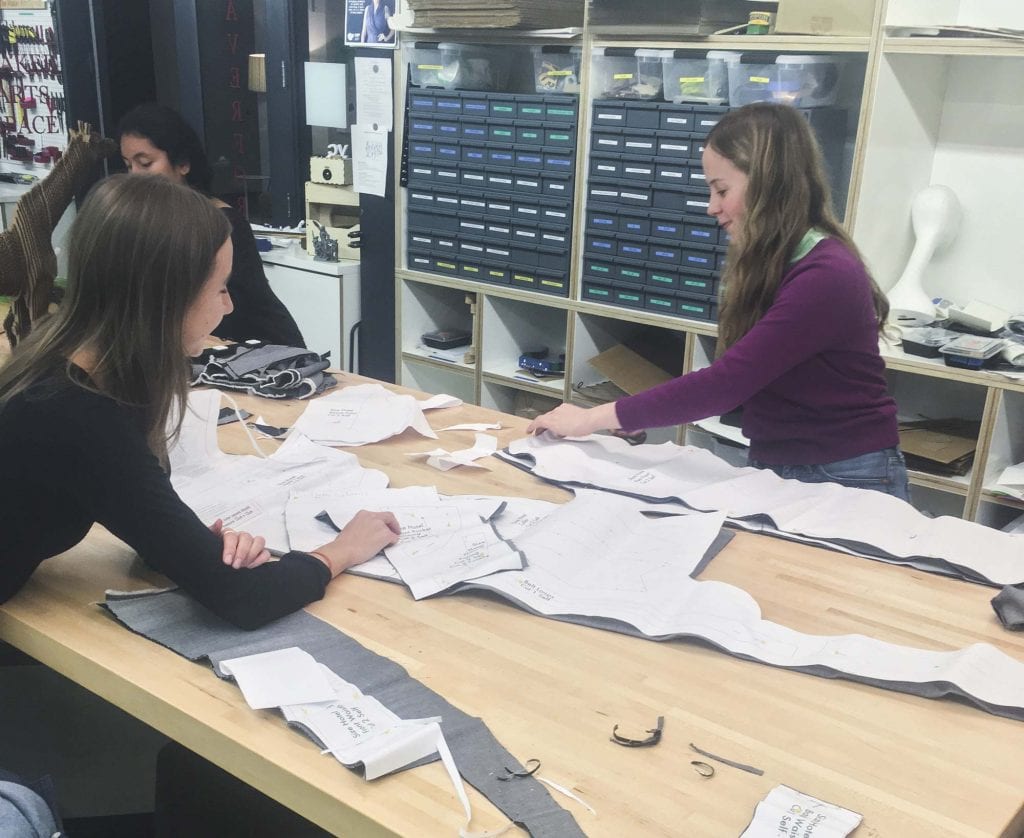
Are you working on a project that involves fabric or sewing? Did you attend the ‘Make your own JUMPSUIT’ event? Want to make your own clothes but don’t know where to start? Join textile artist Paige Fetchen in the VCAM Maker Arts Studio for open hours where she will be available to field questions about all things sewing, textiles, fashion, and design. Stop in to work on your project with expert guidance. Sewing machines and thread provided. Fetchen held workshops on Saturday, Nov 9th, 2-6pm; Thursday, Nov 14th, 4-8pm; and Saturday, Nov 16th, 2-6pm.
Photo Credit: Stephanie Bursese
Huntington Yarn Mill w/ Majid Jaraha, Owner & Peter Woodall, Hidden City Philadelphia
Site Visit
11.15
12:15-4:00pm, Huntington Yarn Mill, 3114 E Thompson St, Philadelphia, PA
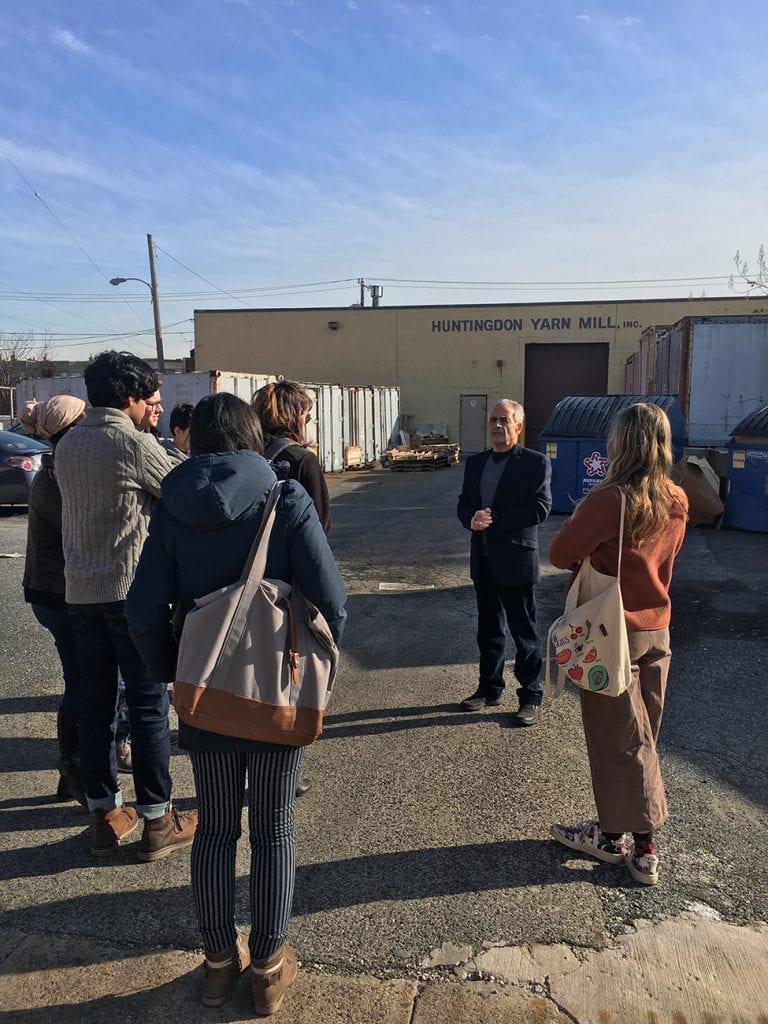
Students from Elisabeth Evans’ course “Industry and the Environment” arrived by bus and filed into Huntingdon Yarn Mill, a domestic supplier producing yarns in Philadelphia, PA since 1940. To begin the tour, Majid Jaraha, the co-owner of the yarn mill, gave a talk about the history of the buildings and an overview of the natural dying process. The students were split into two tour groups, each tour group was led by a staff member of the Yarn Mill. The groups were led through every stage of the spinning, dyeing, and drying process which spans multiple buildings on the yarn mill property. Jaraha explained how the business creates custom colors for big fashion brands and how Huntingdon has adapted their machinery and processes during 80 years of operation. Each individual was able to take home a large spool of yarn from their recycling bin and look through their massive fiber library on site.
To learn more about the yarn mill, read “Textile Industry Lives on in Port Richmond” by Theresa Stignale, published on Hidden City’s website in 2012.
Photo Credit: Stephanie Bursese
Indigo Natural Dying Workshop w/ Theresa Hill, Wild Hand
Course Visit & Workshop
11.22
1-4:30pm, KINSC Lab, Haverford College
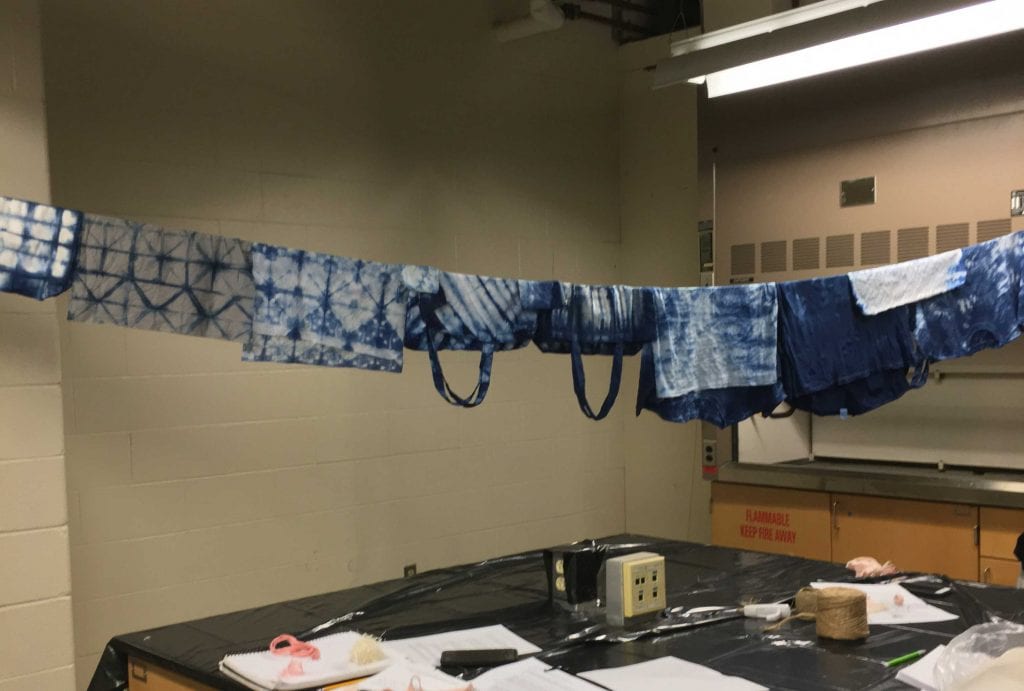
Students from Elisabeth Evans’ course “Industry & the Environment: Understanding Environmental Responsibility within the Textile Industry” learned about natural indigo dye from Theresa Hill, a fiber artist at Wild Hand.
Wild Hand is a Philadelphia-based community of caregivers, crocheters, women, teachers, tutors, queer and proud, friends, veterans, knitters, explorers, weavers, spinners, all things fiber, recovering nice white girls, dyers, grandmas, moms, wives, survivors, lovers, students, perpetually on a learning curve, sewers, thoughtful, and embracing the creative peace within.
Photo Credit: Stephanie Bursese
Fashioned Fast Share Out w/ Paige Fetchen, Artist & RDS, Lead Artists
Presentation & Workshop
12.13
1:00-4:30pm, VCAM, Haverford College
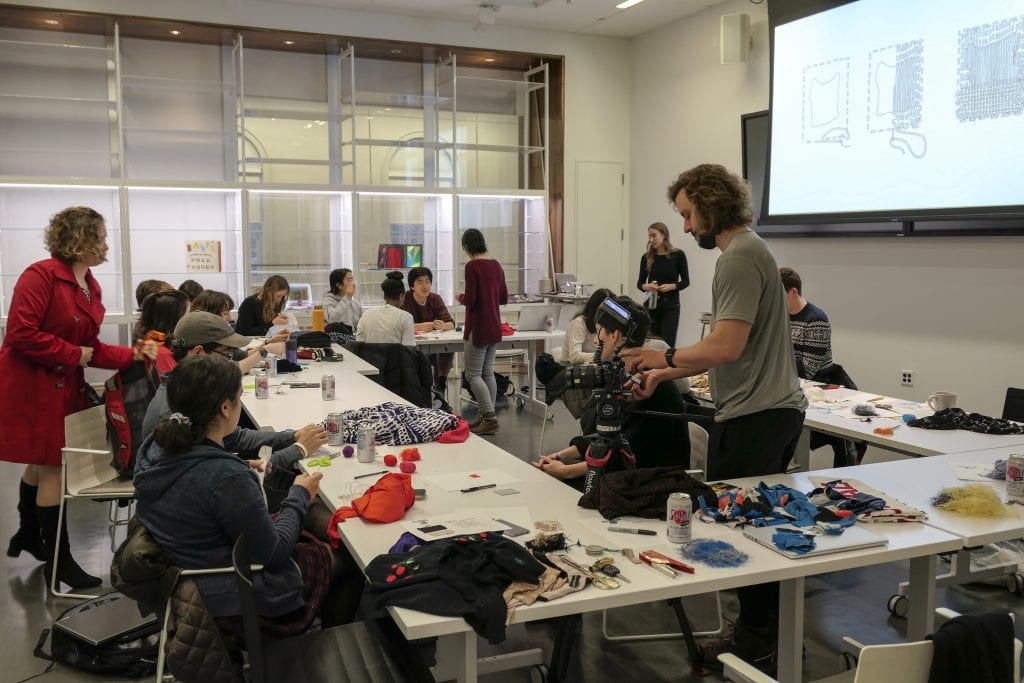
Students from Elisabeth Evans’ course “Industry & the Environment: Understanding Environmental Responsibility within the Textile Industry” met for their final class with Paige Fetchen, fiber & textile artist, and both members of Rational Dress Society. Elisabeth Evans gave a presentation on issues in the textile industry titled “Where do all the Fibers Go?” and Paige Fetchen led a workshop on mending & darning in addition to giving a talk about contemporary artists who use mending in their artwork. Throughout these events, the students worked on small scraps of recycled clothing, separating the recycled fabric into individual threads. This material was collected and used to develop a non-woven fabric prototype.
Photo Credit: Stephanie Bursese
Carding Test at Jefferson for Non-Woven Fabric w/ Brian George, Director of Graduate Engineering Programs
Site Visit & Prototyping
1.8.20
10-11am, Thomas Jefferson University, Philadelphia, PA
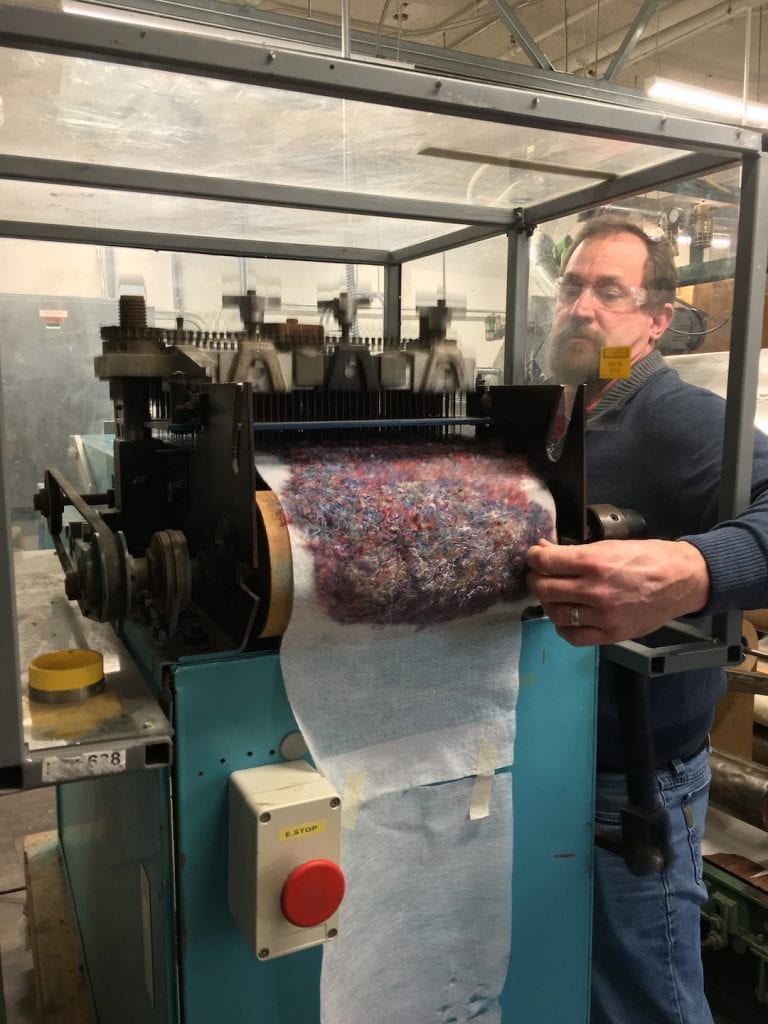
Elisabeth Evans and Stephanie Bursese met Brian R. George, Ph.D., Associate Professor, Engineering Director of Graduate Engineering Programs, School of Design & Engineering at Jefferson to create a non-woven fabric prototype from the recycled clothing fibers we had accumulated during the semester. First, we fed the loose threads into a machine that brushed and mixed the materials, then we fed those fibers into the carding machine to create a semi-flat piece of material.
Photo Credit: Stephanie Bursese
